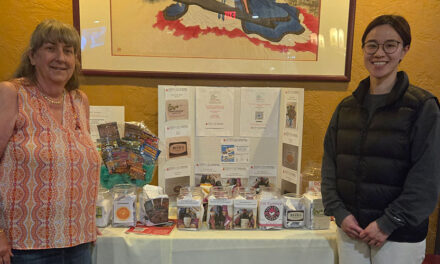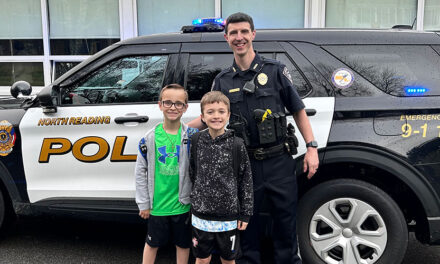Published February 4, 2021
By ALLIE HASTINGS
NORTH READING — Over the past year, schools across the country have been dealing with their own unique set of struggles in response to the novel coronavirus, with teachers and students trying to find pieces of normalcy to hold on to amidst the uncertainty. Fortunately, due to the commitment and perseverance shown by several school administrators, faculty members, and dedicated families, the town of North Reading has managed to weather through these storms brought upon by the pandemic.
Dr. Patrick Daly assumed his role as Superintendent of the North Reading Public Schools in January of 2020, right before schools were forced to shut down in March. As teachers taught remotely during the last few months of the spring term, Dr. Daly and his colleagues were able to learn a lot about the challenges and setbacks of remote learning and began to discuss possible plans for the future, always keeping the goal of in-person learning in mind.
One of the major reasons North Reading was able to re-open its schools on time, come fall, is because administrators like Dr. Daly along with the School Committee, led by Chair Scott Buckley, held a lot of forums for both parents and the teachers’ union over the summer, to encourage an open and honest dialogue of conversation. Buckley, who is a parent of three himself, wanted to make sure that members of the community were provided with numerous opportunities to make their concerns heard.
“I think when everybody feels invested in the process and feels like they have a voice, they will accept the solution much more, rather than somebody saying we know better than you and we’re going to tell you how it goes,” Buckley explained.
In addition to hosting these forums, Dr. Daly revealed that North Reading school administrators were proactively meeting with other members of the community, including the Town Administrator, Fire Chief, Police Chief, the Director of Public Health and the Public Health Nurse, as early as last March, to understand the gravity of COVID-19 and how it might affect North Reading’s public school system in the long-run.
This community-wide effort to tackle the coronavirus head-on led to the creation of a comprehensive hybrid model learning plan, which remains in effect at all five public schools. The model was designed so that teachers can still teach from the comfort of their classrooms, while students in grades 1-12 experience a mix of both in-person learning and remote learning.
To keep class sizes reduced, Cohort A attends school in-person on Mondays and Tuesdays and Cohort B attends school in-person on Thursdays and Fridays. Wednesday is a rotational day, meaning that Cohorts A and B take turns attending school in-person so that every student has equal exposure to the classroom and class resources. Additionally, at the elementary level, Wednesdays are a half-day each week to enable teachers to collaborate with each other on Wednesday afternoons.
Paraprofessionals, long-term substitutes, and remote learning assistants have been tremendously helpful in allowing teachers to carry out their lesson plans under the hybrid model. Since the remote aspect of the hybrid model depends on technology, school administrators have put more digital initiatives in place to ensure that students at home are receiving the best possible alternative to in-person learning.
“Our Digital Learning Director, Dr. Downs, and our entire Digital Learning Team have been instrumental in supporting our teachers on how to use Google classroom, how to make videos, and how to use tools and resources,” stated Dr. Daly.
At the Middle School level, teachers will often wheel carts around the building when moving from classroom to classroom, all while staying connected to their students via Google Meeting.
“The teachers are pretty much running live classes all day long,” affirmed Middle School Principal Dr. Catherine O’Connell. “The teachers have done an unbelievable job.”
Buckley also credits high school teacher and NREA President Peter Kane as being a huge advocate for the reopening of North Reading’s public schools and is grateful to have received his support over the summer months for a safe return to school this past fall. Likewise, faculty members like Dr. Daly and Dr. O’Connell recognize that every instructor has taken on more than they ever have before and are immensely thankful to have witnessed the staff’s collective devotion to teaching in the midst of these unprecedented times.
While plans and schedules under the hybrid model have been functioning in a relatively smooth and productive manner for North Reading’s public school district, both the School Committee and school administrators acknowledge that it is not ideal, nor is it always foolproof.
“The hybrid model – especially the remote learning piece – is not working for every student,” admits Dr. Daly. “It’s been very difficult for a lot of students and families, and we fully recognize that.”
In an effort to address and meet the needs of those who primarily focus best in an in-class setting and those who may be immunocompromised or otherwise at-risk of contracting COVID-19, the school board approved two other cohorts to the hybrid model when it was introduced in August: Cohort C, a fully in-person option that allows students to come to school five days a week, and Cohort D, a group designed for those who opt-in to full remote learning.
Finding creative ways to
remain engaged
In response to the hybrid model, teachers and students have found creative ways to remain engaged with others over the last several months. Bill Cassell, a third grade teacher at the Batchelder School, has set up his classroom experience so that students can assume speaker roles when they are physically in the building. Additionally, he often shares puzzles and riddles with his students during snack time, to keep them actively involved in class discussions.
While Cassell misses regular in-person classes and all the hands-on projects he typically completes in a normal school year with his students, he realizes that the hybrid model experience has given him the opportunity to use every minute to the fullest.
“If I were to go back to regular teaching, I think I would be able to do much more with students as a result of having to use time so efficiently here,” he reflected.
High School junior and Student Representative to the School Committee Shivi Srikanth also reported that her friends and peers have been creative in finding ways to stay connected with each other throughout the pandemic. Socially distanced hangouts in backyards have become a common occurrence, but in the colder months, students have resorted to meeting virtually and participating in safe community service activities together.
As Srikanth optimistically noted, “My peers and I have been resilient in the face of uncertainty, and I don’t see that strength going away anytime soon.”
Despite their adaptability, both Srikanth and Cassell are looking forward to the day when school can resume as normal, as nothing beats the personal connections that stem from in-person learning experiences.
“When you have all your students in one place, and you have a teachable moment…you’re teaching everybody that teachable moment,” stated Cassell.
Contact tracing protocols and COVID-19 testing plans
In terms of contact tracing protocols, the school nurses have been diligently working in conjunction with public health nurse Pam Vath to ensure that those who have been exposed or test positive for COVID-19 are informed about quarantine procedures immediately. If a student does test positive, the school nurses are notified and work with the administrators and teachers to figure out who the student may have come into contact with for a cumulative 15-minute period within six feet.
The school board is currently exploring two different types of testing for COVID-19 , one being “symptomatic testing” which is almost ready to roll-out. Under this scenario, students and faculty members experiencing COVID-19 symptoms would go to the nurses’ office to get a rapid test and would then receive their results within 15 minutes. A second method school administrators are currently looking into is called “pool testing” which entails testing to see if anyone in a particular “pool” of people has the virus. Community updates regarding roll-out should be announced to the public shortly once final plans are approved.
Fortunately, North Reading’s district has seen a very low transmission rate of COVID-19 occurring within the school buildings, due to the contact tracing protocol system and the smart decisions that students are making in an effort to remain in school and keep their peers safe. Per the town’s public health nurse has repeatedly stated that the town’s schools are some of the safest places for staff and students to be, according to Dr. Daly.
Importance of following social
distancing guidelines
Due to a few recent spikes and the community at-large numbers, however, administrators and concerned parents warn that the tables could turn at any moment, forcing North Reading to shut down its largely successful hybrid model.
In order to prevent that scenario from becoming a reality, Dr. Daly recommends that students avoid large gatherings and wear masks at all times, even when carpooling with those who may be outside of one’s immediate household. The incidents of positive cases that the school board has seen within recent weeks involve groups of three to four people becoming exposed to the virus outside the classroom, so in order to stop the spread, friend groups must work hard to stay six feet apart.
But all in all, the students in North Reading have done an incredible job in meeting all the social distancing requirements, and they are a large part of why the hybrid model has been able to continue operating.
“We have some amazing students in our district, and they have helped lead the way in trying to come up with solutions. The students have been very respectful and accommodating…they’ve given up a lot, but I think everybody understands where we’re at,” said Buckley.
Positive outlook and plans for the future
As Dr. Daly, Dr. O’Connell, Chairman Buckley, and members of the community at-large were able to come together and create a comprehensive but fully accommodating hybrid model learning plan, they remain hopeful that North Reading will continue to see areas of growth and improvement in the next few months.
A Social Emotional Well-being Faculty Meeting will be held at the Middle School in February, an event which will be centered on the topic of emotional regulation and how to practice self-care strategies. The school district is also considering a few different activities for the month of March that would serve to boost student morale and encourage everyone to finish the spring term off strong.
For the coming 2021-22 school year, school administrators are striving to achieve two main goals – the first being figuring out how to return to in-person learning for all students as soon as possible.
The second goal relates to securing social justice and equity for all students. Dr. Daly explained that the school board is examining how the curriculum and instructional approaches to teaching the curriculum can improve, as well as how the faculty can work through any biases to provide a better educational experience for all students.
Srikanth is also President of North Reading’s Youth for Antiracism club (NRY4A) so she will play a major role in helping to accomplish this goal by organizing civic action projects and getting her fellow peers involved in racial justice initiatives.
To stay up to date on the public school district’s plans regarding COVID-19, those interested may visit https://www.north-reading.k12.ma.us/district/news/covid-19-information to view dashboard statistics and read Dr. Daly’s latest community blog posts.




